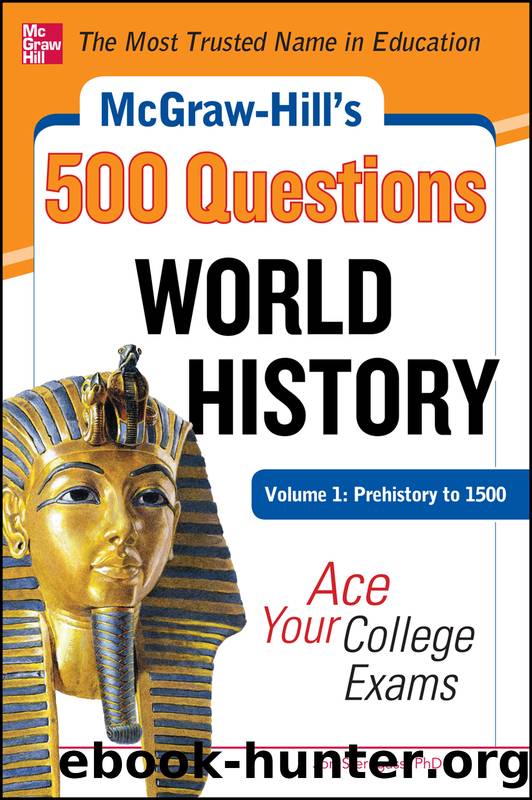McGraw-Hill's 500 College World History by Jon Sterngass

Author:Jon Sterngass
Language: eng
Format: epub
Publisher: McGraw-Hill Education
Published: 2012-06-14T16:00:00+00:00
Chapter 7: India Through the Gupta Empire
226. (D) Although Buddhism never developed a missionary movement, Buddha’s teachings nevertheless spread across the Indian subcontinent and from there throughout Asia. In each culture, Buddhist methods and styles were modified to fit the local mentality without compromising the essential points of wisdom and compassion. When Buddhist traders and merchants visited and settled in different lands, some members of the local population naturally developed an interest in the foreigners’ beliefs. This occurred in the oasis states along the Silk Road in central Asia from about 200 BCE to 200 CE. As local rulers and people learned more about this Indian religion, they invited monks from the merchants’ native regions as advisers or teachers. In this manner, many Asians eventually adopted the Buddhist faith. However, Shinto, Jainism, and Zoroastrianism remained confined mainly to Japan, India, and Persia, respectively. Judaism spread through the various Jewish diasporas.
227. (D) Broomyard millet is a kind of grain that grows wild in Asia. Hunters and gatherers in Neolithic China probably ate millet, and the first signs of its cultivation date to 7500 BCE in northern China. The domestication of rice in the Yangtze River valley may have taken place at the same time, but the first signs of agriculture date to about 5000 BCE. Wet-field cultivation of rice in paddies probably became popular in the first millennium BCE. In India, rice is first mentioned in the Yajurveda, probably written between 1400 and 1000 BCE. Rice paddies are perfectly suited for the seasonal monsoons of the Indian sub-continent. Spices grew wild but were soon cultivated as preservatives and curatives. Bananas and plantains were first domesticated in southeast Asia, while yams may have originated in both Asia and Africa. (Poi is not a plant, but a Polynesian staple food made from the bulbous root of the taro plant.)
228. (A) Chandragupta Maurya (c. 340–298 BCE) was the founder of the Maurya Empire (321–c. 180 BCE). He conquered most of the Indian subcontinent and is considered the first genuine emperor of India. After his conquests, the Maurya Empire extended from Bengal to Assam in the east to Afghanistan in the west and from Kashmir and Nepal in the north to the Deccan Plateau in the south. Chandragupta Maurya’s government was supported by taxes on agriculture, while standardized coinage throughout the empire helped trade. The government’s control of manufacturing, mining, and shipbuilding strengthened the state. Chandragupta Maurya’s powerful army consisted of infantry, cavalry, chariots, and war elephants. He did not, however, favor one religion over another. He gave up his throne toward the end of his life and became a follower of a Jain saint.
229. (A) A monsoon is traditionally defined as a seasonal reversing wind accompanied by corresponding changes in precipitation. Usually, the term refers to the rainy phase of a changing seasonal pattern, but there is also a dry phase. The prevailing summer winds of the Indian subcontinent—summer monsoons—blow northeastward off the Indian Ocean and deposit considerable rain. The mountain barriers capture the rain and drain it into three major river systems: the Brahmaputra, Ganges, and Indus.
Download
This site does not store any files on its server. We only index and link to content provided by other sites. Please contact the content providers to delete copyright contents if any and email us, we'll remove relevant links or contents immediately.
Hit Refresh by Satya Nadella(9083)
The Compound Effect by Darren Hardy(8870)
Change Your Questions, Change Your Life by Marilee Adams(7684)
Nudge - Improving Decisions about Health, Wealth, and Happiness by Thaler Sunstein(7656)
The Black Swan by Nassim Nicholas Taleb(7055)
Deep Work by Cal Newport(6966)
Rich Dad Poor Dad by Robert T. Kiyosaki(6513)
Daring Greatly by Brene Brown(6473)
Principles: Life and Work by Ray Dalio(6296)
Playing to Win_ How Strategy Really Works by A.G. Lafley & Roger L. Martin(6082)
Man-made Catastrophes and Risk Information Concealment by Dmitry Chernov & Didier Sornette(5956)
Digital Minimalism by Cal Newport;(5704)
Big Magic: Creative Living Beyond Fear by Elizabeth Gilbert(5676)
The Myth of the Strong Leader by Archie Brown(5456)
The Slight Edge by Jeff Olson(5376)
Discipline Equals Freedom by Jocko Willink(5336)
The Motivation Myth by Jeff Haden(5175)
The Laws of Human Nature by Robert Greene(5080)
Stone's Rules by Roger Stone(5051)
